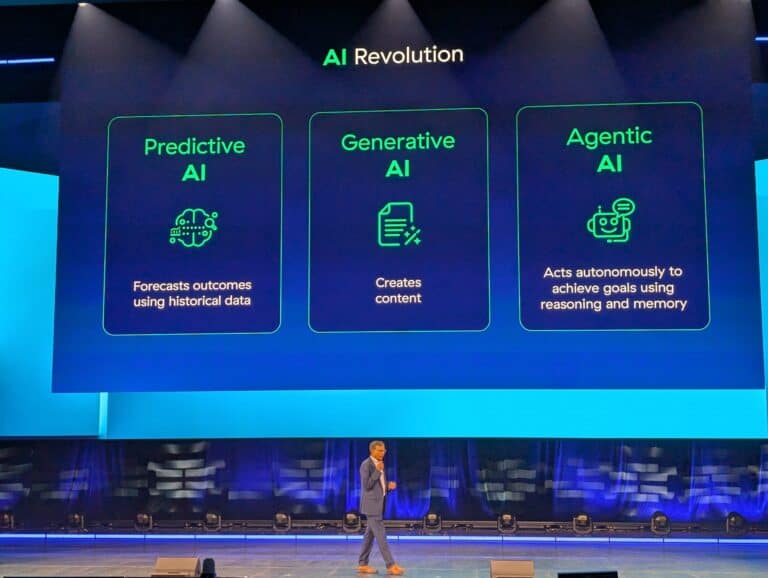Every so often, a technological innovation emerges that radically changes the way we work. Today, that innovation is undoubtedly AI. The new wave is changing work in many ways, but it is also presenting companies with serious security challenges. How can you stay afloat in this AI storm? According to Zscaler CEO Jay Chaudhry, the answer lies in a different approach to cybersecurity, with Zero Trust as your compass.
Zscaler has been around for about 18 years. During that time, the Zero Trust Exchange, as the platform is called, has undergone various developments. For example, Zscaler’s architecture was designed from the outset with the priority of data privacy in mind, as Europe attaches importance to this issue. Our content is generally subject to strict data standards. The advantage now is that Zscaler has an answer to current questions about sovereignty. When using the platform, log files are stored within the users’ regions.
However, the entire hybrid work situation that has accelerated over the past five years was also easily accommodated thanks to the design of the Zero Trust Exchange. Users, applications, and data became increasingly distributed. This made traditional network security, based on perimeters and firewalls, less effective. Since its inception, Zscaler has been campaigning against this old world and is seeing wider acceptance of its approach within the industry. Whereas in the past all traffic was routed through central security points, modern applications communicate directly with cloud services and mobile end users.
In this context, it makes sense that the traditional VPN connection has had its day. Modern security operates like a digital highway: users and applications must be able to find each other securely, regardless of their location. This requires a cloud-based approach that focuses on identity, context, and minimal access rights: the basic principles of a Zero Trust architecture.
Read also: “Firewalls will become like mainframes, Zero Trust is the way forward”
Challenges in AI security
With its platform as a foundation, Zscaler now sees itself as a safe haven in a host of AI-related matters. After all, Chaudhry sees AI as the next big wave, comparable to the impact of the Industrial Revolution on physical labor. It is a revolution in which knowledge workers are faced with increasing automation. Recently, agentic AI has been acting autonomously to achieve specific goals using perception, reasoning, and action capabilities.
At the same time, AI is both an advantage and a disadvantage for security. Zscaler itself, for example, uses predictive AI to detect zero-day attacks via sandboxing technology. However, autonomous agents pose security risks. “What if these agents are hacked?” Chaudhry wonders. Malicious actions could include incorrect stock trading, wrong medical procedures, or incorrect inventory management. Organizations need to embrace AI in a secure way rather than avoiding it altogether.
Why Zero Trust + AI is a match
Zscaler combines AI with the Zero Trust principle, which focuses on scale and context. With more than half a trillion transactions and half a quadrillion telemetry signals every day, the platform has a vast amount of data at its disposal to identify threats. This data is further enriched with insights from Zscaler’s own ThreatLabz team and external intelligence feeds. This combination enables the AI to continuously learn.
This results in tools such as AI Auto Data Discovery, which uses AI to automatically detect sensitive data in SaaS apps, emails, and encrypted traffic. Data classification for SaaS services, private apps, devices, email, and encrypted traffic is automatic and contextual. AI also helps with connection problems, for example, within Zscaler Digital Experience, where a single click indicates whether the problem lies with the user, the network, or the application, based on root cause analysis.
Because the Zero Trust model restricts every action to predefined access rights, control is always maintained. AI thus offers speed, efficiency, reliability, and security.
Zero Trust implementation accelerates
Chaudhry is also seeing a change in the market’s attitude toward Zero Trust security. Ten years ago, the majority of CISOs would have rejected cloud-based security. Only a small minority would consider embracing it. Today, the market dynamics have changed. Just about every company wants cloud security. Even traditional firewall vendors now claim to offer Zero Trust capabilities, although Chaudhry argues that true Zero Trust requires a fundamentally different architecture than traditional security approaches.
The CEO emphasizes that organizations cannot work with AI or fight against it; instead, they must work with it. “It’s our job to ensure that you can embrace AI in a very secure way,” he concludes. By combining Zero Trust architecture with AI security capabilities, companies can move forward faster while protecting against ever-changing threats.
